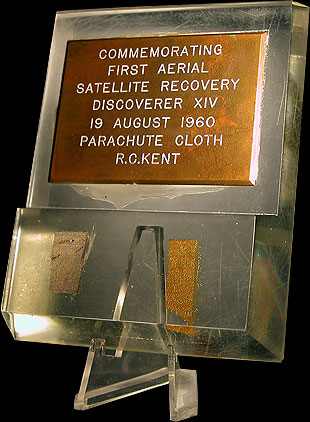
Discoverer XIV was the first satellite to be ejected from an orbiting vehicle and to be recovered in mid-air.
Discoverer XIV was launched into a polar orbit by a Thor booster from Vandenberg Air Force Base, California, on August 18, 1960. The satellite achieved an orbit of 116 miles perigee and 502 miles apogee. During its 17th orbit, Discoverer XIV was ejected from its Agena A fairing and retrorockets fired to slow it for the return from orbit.
After Discoverer XIV reentered the atmosphere, it released a parachute which was sighted 360 miles southwest of Honolulu, Hawaii, by the crew of a U.S. Air Force C-119 recovery aircraft. On its third pass, gear trailing behind the aircraft snagged the parachute canopy.
Discoverer XIV was reeled into the aircraft after its 27-hour 450,000 mile journey through space.
The satellite, most of its parachute, and the C-119 that captured it are on display at the U.S. Air Force Museum in Dayton, Ohio. These two small parachute segments were presented to R.C. Kent, who worked on the recovery.

© 2020 collectSPACE.com All rights reserved.
Questions? E-mail [email protected]

|